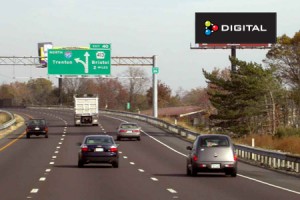 Everyone has seen them. Quite frankly, it’s impossible to miss them. While focus has been on driver distractions of cell phone usage and texting, another driver distraction has been emerging . . . electronic billboards! With this new technology, motorists are drawn visually to a large screen color and light show, much like a TV on a stick. Electronic billboards (EBB) typically are seen along major highways and turnpikes. But that may soon be changing in Tredyffrin Township if a change in zoning is permitted.
Everyone has seen them. Quite frankly, it’s impossible to miss them. While focus has been on driver distractions of cell phone usage and texting, another driver distraction has been emerging . . . electronic billboards! With this new technology, motorists are drawn visually to a large screen color and light show, much like a TV on a stick. Electronic billboards (EBB) typically are seen along major highways and turnpikes. But that may soon be changing in Tredyffrin Township if a change in zoning is permitted.
I can think of 3 billboards in the township although there may be more. There is one billboard on Lancaster Avenue in Devon, across from the BMW dealership; a small billboard next to Clockworks in Paoli by the Amtrak overpass (intersection of 252 and Rt. 30); and the third billboard is located on Rt. 252 at Radbill Park across from the entrance to Daylesford Lake. The Radbill Park billboard is the one that will be discussed at the Planning Commission meeting this Thursday. The Planning Commission agenda includes the following item:
Presentation by Clear Channel Outdoor Inc for proposed ordinance and zoning map change for Radbill Park: ORDINANCE AMENDING SECTION 208-8 OF THE TREDYFFRIN TOWNSHIP ZONING ORDINANCE, AS AMENDED, AND THE ZONING MAP OF TREDYFFRIN TOWNSHIP BY RECLASSIFYING A PROPERTY ON THE EASTERN SIDE OF ROUTE 252, SOUTH OF HOWELLVILLE ROAD AND WEST OF THE PENNSYLVANIA RAILROAD TRENTON BRANCH FROM THE PRESENT R-1 RESIDENCE DISTRICT CLASSIFICATION TO THE C-1 COMMERCIAL ZONING DISTRICT.
The proposal is to change the current R-1 (residential) zoning of the Radbill Park billboard location to C-1 (commercial) zoning. Under present R-1 zoning the traditional billboard cannot be changed to an EBB. To erect an EBB, requires C-1 zoning. You might wonder why Clear Channel and the township would want an electronic billboard and there’s an easy explanation . . . money.
Under the present 6-year contract with Clear Channel (which is due to expire shortly) the lease agreement is approximately $29K per year to the township. However, with multiple advertisers on an electronic billboard, the lease agreement would include higher rental revenue to Clear Channel and to Tredyffrin Township. Significant increase in revenue . . . not sure, but certainly more than $29K per year.
So why should we care if the township rezones the Radbill Park billboard location from R-1 to C-1 to permit EBB? After all, we know that it will increase township revenue and in today’s economy, that would seem to be a good idea. In my opinion, there are a number of good reasons not to permit the billboard change. I have several concerns in regards to changing the zoning to C-1 to permit EBBs . . . first, I believe that an EBB at Radbill Park will cause ‘quality of life’ issues for residents of Daylesford Lakes and Daylesford Estates. (I have been told by a number of residents that at night the lights of the current billboard sign are intrusive, I can only imagine how invasive an electronically lit billboard streaming in to their homes, 24-7 would be) . Secondly, I believe that electronic LED billboards belong on major highways or the turnpike not in a residential setting.
However, my biggest concern in regards to EBBs is the safety issue. A 2009 report, by ergonomics consultant Jerry Wachtel, developed for the American Association of State Highway and Transportation officials, confirms three issues about electronic billboards — (1) EBBs attract eyes away from the road for extended, unsafe periods of time (2) signs should not be placed near interchanges or where drivers face challenging conditions, and (3) the youngest and oldest drivers face higher driver safety risks with regard to EBBs.
It is important to review reason #2 in the report . . . challenging conditions. If you live in Daylesford Lake and you exit to Route 252, the proposed EBB is directly in front of you. Already dangerous for exiting Daylesford Lake residents (particularly if crossing Route 252 south lanes to go north on Route 252), they will now have to contend with drivers distracted by the proposed electronic billboard. If there was ever a prescription for an accident, this could be the one.
I thought it would be interesting to look at how other parts of the country are coping with the new movement of electronic billboard advertising. In the spring, Denver banned EBBs, citing safety concerns. St. Louis passed a one-year moratorium. Michigan and Minnesota are holding hearings to impose a two-year moratorium and four states ban billboards completely. One EBB can utilize the equivalent electricity in one year of 52 homes, so “When every stretch of highway in America looks like Times Square, it will be too late to worry about the driver distractions caused by electronic billboards,” said the Philadelphia Inquirer in “Roadside Distractions” on March 22.
Unlike a cell phone, a person cannot choose to turn them off. Do we think that additional revenue from an electronic LED billboard out-weighs quality of life and safety issues? Would love to hear an opinion on electronic billboards from the two State House 157 Representative candidates.
